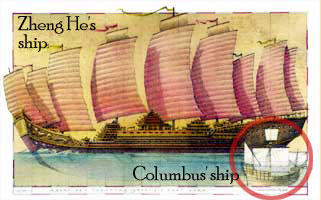|
Digital
History>eXplorations>The
World Before 1492
Exploration
2: Zheng He
Essential
Questions
-
Who is Zheng He and what is his historical significance?
-
Why did China make the momentous decision to turn away from
the outside world?
-
Why did tiny Portugal, in contrast, led Europe into an age
of exploration?
 |
What
differences do you notice about these two ships?
Columbus' ship, the Santa Maria: 85-90
feet long
Zheng He's ship: 400 feet long |
Several
decades before Columbus sailed to the New World, a Chinese
admiral named Zheng He made even more ambitious voyages. Between
1405 and 1433, Zheng He led seven major expeditions, commanding
the largest armada the world would see for the next five centuries.
Not until World War I did the West mount anything comparable.
Zheng
He's fleet included 28,000 sailors on 300 ships, the longest
of which were 400 feet and 160 feet wide. By comparison, Columbus
in 1492 had 90 sailors on three ships, the biggest of which
was 85 feet long. Zheng He’s armada included supply
ships to carry horses and as many as 20 tankers to carry fresh
water. His crew included interpreters for Arabic and other
languages, astrologers to forecast the weather, astronomers
to study the stars, pharmacologists to collect medicinal plants,
ship-repair specialists, doctors and even two protocol officers
to help organize official receptions.
Zheng
He’s fleet reached Africa and could easily have continued
around the Cape of Good Hope and established direct trade
with Europe. But the Chinese regarded Europe as a backward
region and had little interest in the wool, beads and wine
Europe had to trade. China preferred the goods that Africa
traded -- ivory, medicines, spices, and exotic woods.
In
Zheng He's time, China and India together accounted for more
than half of the world's gross national product. Indeed, as
recently as 1820, China accounted for 29 percent of the global
economy and India another 16 percent.
But
during the 1400s, China retreated into relative isolation.
By 1500 the Chinese government had made it a capital offense
to build a boat with more than two masts, and in 1525 the
Government ordered the destruction of all oceangoing ships.
A century earlier, China had a fleet of 3,500 ships.
Resources
(Links will open in a new window; close that window
to return to this page)
|
